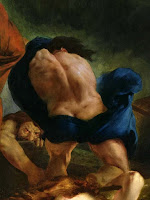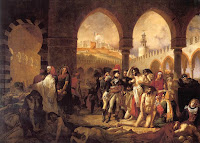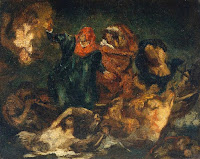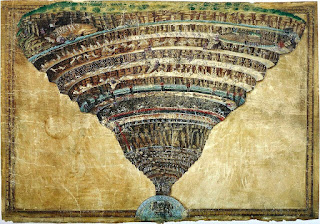The Barque of Dante Analysis
 |
| Self-Portrait by Eugène Delacroix (1837) |
 |
| The Raft of the Medusa by Théodore Géricault (1819) |
The Barque of Dante Story in Historical Context
 |
| The Barque of Dante Detail of Dante Alighieri |
 |
| The Barque of Dante Detail of Virgil |
 |
| The Barque of Dante Detail of Desperate Souls |
 |
| The Barque of Dante Detail of Phlegyas |
Opinions of Judges and Art Critics about the Barque of Dante
 |
| Napoleon Visiting the Plague Victims of Jaffa by Antoine Jean Gros (1804) |
 |
| Self-Portrait by Antoine-Jean Gros (1795) |
Eugène Delacroix’s Notes about the Barque of Dante
 |
| Portrait of Henriette de Verninac by Jacques-Louis David (1799) |
 |
| The Barque of Dante after Delacroix by Édouard Manet (1854-1858) |
The Barque of Dante Painting and Inferno
 |
| The Map of Hell by Sandro Botticelli (1485) |
 |
| Cerberus by William Blake (1824-1827) |
In the
sixth circle, Heresy, Epicurus and those who followed his philosophy, who
claimed that the soul also perished with the body, were imprisoned in burning
tombs. The Seventh Circle, defined as Violence, is divided into three separate
circles. Dante and Virgil flee from a minotaur and quickly move on to the next
circle. The Eighth Circle is called the Fraud, and false, malevolent and
deceitful spirits live here. The Ninth Circle is constructed as the Treachery.
Trapped in the ice on this floor, sinners are punished, each according to his
own fault, guilty of treason against those with whom he has special relations.
The Barque of Dante by Eugène Delacroix
 Reviewed by Articonog
on
February 02, 2022
Rating:
Reviewed by Articonog
on
February 02, 2022
Rating:
 Reviewed by Articonog
on
February 02, 2022
Rating:
Reviewed by Articonog
on
February 02, 2022
Rating:






No comments: